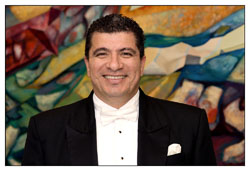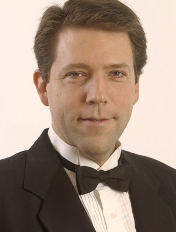
Giancarlo Guerrero
|
Guerrero, music director designate of the Nashville Symphony, not only stepped in for previously scheduled guest conductor Xian Zhang, he bounded in.
Literally bounded, for the Costa Rica born conductor brought such zest with him that he leaped on and off the podium and negotiated his entrances and exits at a run.
In his final season as music director of the Eugene (Oregon) Symphony, Guerrero is also a fabulous conductor with ideas of his own and the technical skills to accomplish them.
It was a beautifully planned program with a seasonal cast provided by Rossini/Respighi’s “La boutique fantasque” (“The Fantastic Toyshop”) and “Winter” from Vivaldi’s “The Four Seasons.” Also heard were Prokofiev’s Symphony No. 1 (“Classical”) and Beethoven’s Romance Number No. 2 in F Major for Violin and Orchestra.
Soloist in the
Vivaldi and Beethoven was CSO principal second violinist Gabriel Pegis in
performances marked by both classical beauty (Beethoven) and keen interpretive
skill (Vivaldi).

It is always good to see one of the CSO’s own step into the solo spot. Pegis occupied it with ease and presence. He enveloped the Romance in a warm, affecting sound, sweet as a sugarplum. Vivaldi’s treatise on stepping carefully over the ice was vividly conveyed. Guerrero and the CSO set the scene at the beginning by stressing the non-harmonic dissonances within the violins’ accompanying trills – a touch of frostbite, as it were. Pegis answered with ever so realistic “shivers” against the cold wind (having just returned from scouring the Christmas markets along the Danube, I can empathize).
The “indoor” Largo, taken at a brisk tempo, was suitably warm by contrast and nicely ornamented by Pegis. The melancholy opening of the finale gave the ending away as Pegis timorously approached the inevitable tumble on the ice and victorious winter swept to a triumphant conclusion.
Guerrero opened with a truly distinctive reading of Prokofiev’s “Classical” Symphony. This youthful work is usually drenched in wit. Not so here. Guerrero elevated charm over satire, putting the emphasis on “classical" and letting the work's modernisms speak for themselves. Textures were crystal clear and every note could be heard, including some that are often obscured. The Allegro con brio was full of exuberance. The second movement (Larghetto) was gentle and genuinely touching, without a drop of treacle, and there was nothing bumptious about the brief, jolly Gavotte.
The Molto vivace finale sparkled like seltzer, with due emphasis on the woodwinds as they bubbled up in combination. Their playing was reflected by the strings who stirred up a similar froth, always with transparency and attention to Prokofiev’s structural details.
Rossini’s toyshop, a kind of forerunner of Disney’s “Toy Story” but with the customers in on the action, was orchestrated by Respighi in 1917 from piano pieces by Rossini and made into a ballet. As such, it brims with life and color, depicting various mechanical dolls -- playing cards, Cossacks, poodles, can-can dancers, but no Buzz Lightyear -- and their successful plot to avoid being sold. This was reflected in Guerrero’s podium manner, which gave telegenic support to the musicians. He did this largely through facial expressions, smiles, frowns, entreaties, raising and lowering his eyebrows, but never surrendering precision with the baton. He allowed himself a leap or two, but could be much more subtle, as by hunching his shoulders now and then. The players responded with vivid playing throughout.
Guerrero was just as generous to the CSO and the audience as to the music itself, blowing kisses all around as he took repeated bows and radiated his joy at being there.
The concert repeats at 8 p.m. December 20 at Music Hall.